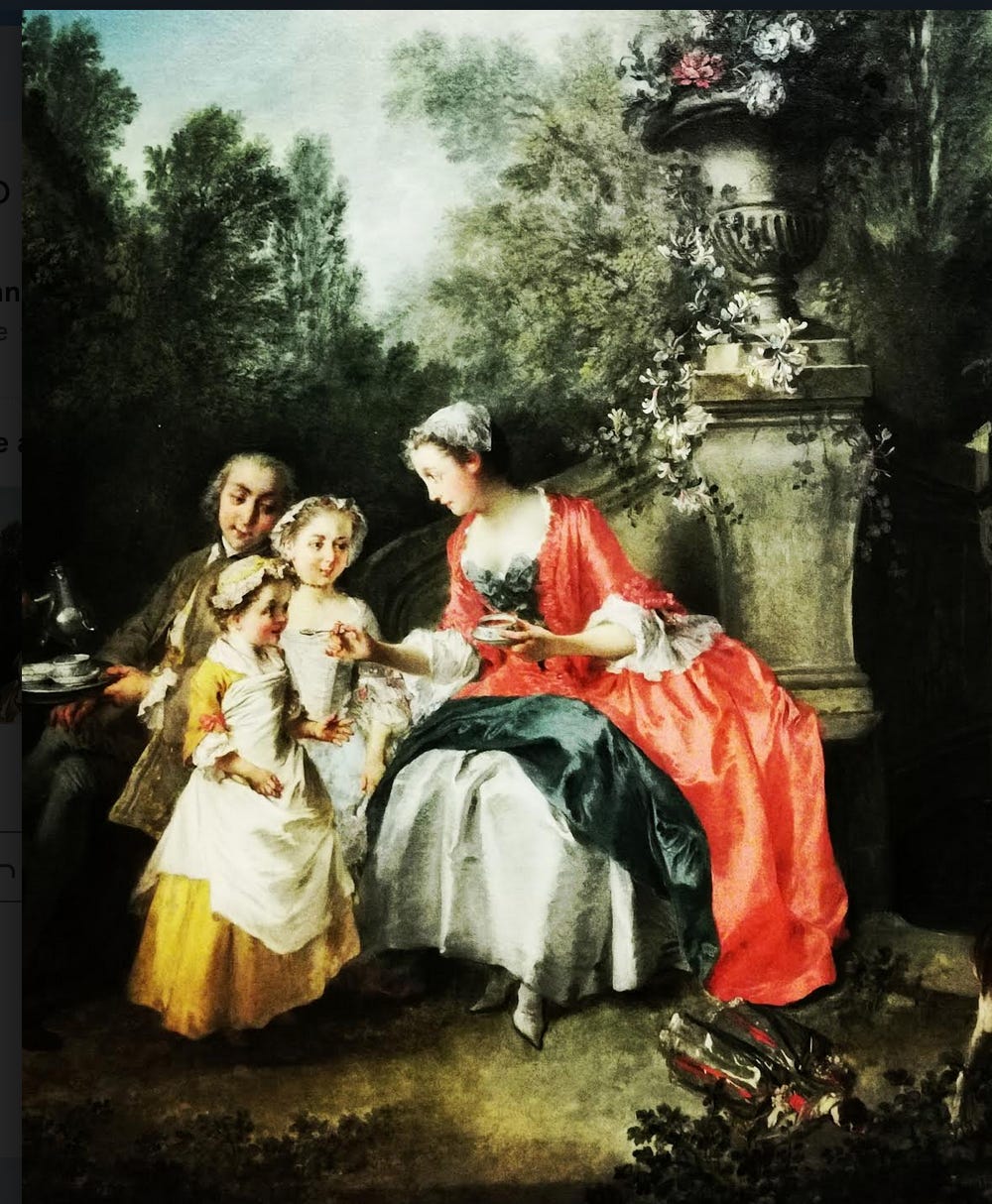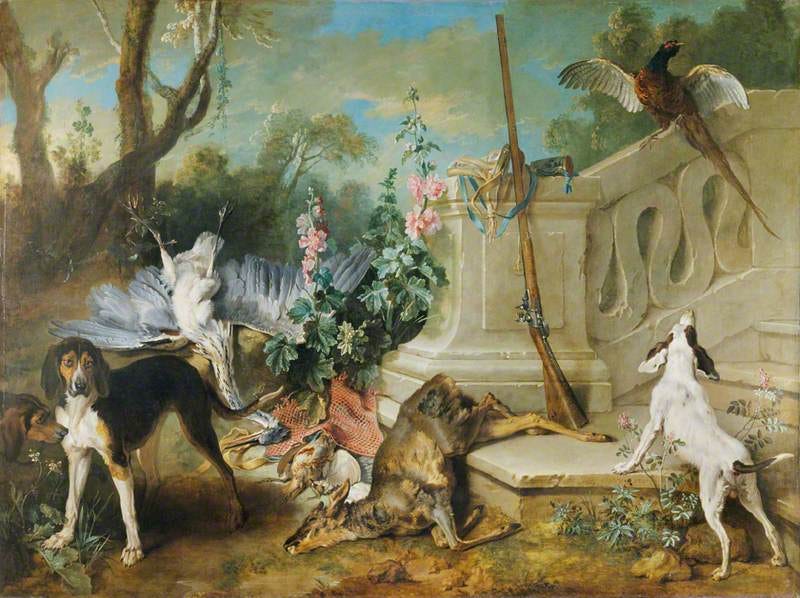I wanted to write about Wake Li my Chinese artist friend and his wife Bai; however, I am editing their correspondence to me. It will be the next Substack post.
Instead, here is a short story about my travels with Violette, my sidekick and her favourite painting.
Throughout all the pandemic
and out the other side, my blessing has been Violette. My muse, my friend, my granddaughter.
We pack our bags and are ready to go. Sometimes we head to the beach at Hastings and find secrets in the shells.
Sometimes we go to London, to the National Gallery, which is her favourite place. She loves the colours and lolling on the benches.
From the gallery we go to Chinatown to eat eggy-rice. Her best friend is Charlie who is Chinese. In fact, Violette thinks London is China and the gallery is a playground.
It was raining again,
that English crying rain, a rain that leaves you anguished. Grey. I just looked up adjectives for grey: characterless, colourless, nondescript, unremarkable, faceless, lifeless, soulless, passionless, spiritless, insipid, jejune, flat, bland, dry, stale, dull, uninteresting, unimaginative, boring, tedious, monotonous, neutral, anonymous, wishy-washy . . .
This was what it was like, all these adjectives and more meshed together. It was going to be a long, long Thursday. So, we packed our wellies (boots for those who do not know the word) and umbrellas, and off we went.
On the way up on the train Vivi kept talking about the lady with the children in a garden. “You have the photo, Lola,” she said. So, we looked at all the pictures of our travels, and here we are in the National Gallery.
A Lady in a Garden having Coffee with Children
is the actual title of the painting by the French artist Nicolas Lancret (1690-1743). What it is that Vivi likes, I am not sure. She can’t tell me; she just likes it.
The children?
The colours against the grey wall?
The room which is vast and often empty?
The dog and the light golden skies? (She is taken by skies at the moment.)
I actually know little about painting and painters. When I go to the gallery with Vivi I see colours, forms, light, texture, and I like or do not like. Movements, styles and classical influences, of them I am ignorant, and slowly walk away when people begin discussing painting. I can just about tell Turner from Monet, true, and the only painter I actually understand and recognise is Hogarth because he paints stories I can relate to.
I ask Andrew, a friend who has studied art history and leaps at the chance to talk to me about his passion. He pulls out the picture from the hundreds of postcards he collects from museums and galleries he has visited. (Andrew’s words are in bold.)
Lancret’s picture is a happy family scene, with a touch of humour, painted in the bright, delicate colours of the Rococo style. The painting was first shown at the Salon exhibition of 1742, the year before Lancret died. A reviewer of this exhibition praised his paintings for their “engaging characters . . . lightness of touch in the brushwork . . . variety in the manner of using colours” (quoted by Humphrey Wine, The Eighteenth-Century French Paintings, National Gallery, 2018, page 305). A valuable review, as it tells us the things contemporaries were looking for in a painting.
The lady’s brightly coloured dress acts as the focus of the picture, and its colours of reddish orange and greenish blue are distributed in small touches throughout the painting: red flowers, blue sky, blue water.
The composition is carefully constructed: the family group forms a broad pyramid, which is balanced on the other side by a circular pool, and the two halves of the painting are divided by the tall urn in the centre. But this construction is skilfully masked by the soft forms of trees, flowers, and clouds, which all help to unify the painting.
Jeanne: What is the mother giving the little girl to eat?
The lady appears to be giving her child a canard, a lump of sugar soaked in coffee. Canard is the French word for a duck, and the sugar lump dipped in coffee must be an allusion to a duck diving under the water.
I do a search about dunking sugar lumps into coffee and find this amusing account:
In his Dictionnaire de la langue verte, published in 1866, Alfred Delvau gave the following definition: Morceau de sucre trempé dans le café, que le bourgeois donne à sa femme ou â son enfant, - s'ils ont été bien sages. Depuis, même les femmes pas très sages, et Dieu sait si elles sont nombreuses, peuvent avoir droit à leur canard, et bien plus souvent trempé dans le verre d'alcool fort de leur voisin de table que dans du café.
A piece of sugar soaked in coffee, which the bourgeois gives to his wife or child - if they have been very good. Since then, even women who are not very well-behaved, and God knows how many of them there are, can have their duck, and much more often dipped in the glass of strong alcohol of their table neighbour than in coffee
The coffee and the sugar consumed by the family probably both came from the French West Indies. French coffee production rivalled that of the Dutch, whose coffee came from their own colony of Batavia (Indonesia). The silver coffee pot held by the servant in Lancret’s painting has a wooden handle to prevent the holder from being burned, and similar coffee pots are still in use today. The dainty coffee cups appear to be made of Saint-Cloud porcelain. The coffee pot and the cups also act as status symbols indicating that the family has both money and taste.
Jeanne: Coffee was only for the rich, obviously.
Yes, the coffee and the sugar both came from plantations worked by slaves in the French West Indies.
There was a shortage of labour at the plantation. So, Europeans solved this problem by a triangular slave trade between Europe, Africa and America. Slave trade began in the 17th century. French merchants sailed to the African coast to buy slaves from their local chieftains. The slaves were packed in the ships for a three-month voyage across the Atlantic to the Caribbean. There, they were sold to plantation owners. Exploitation of slave labour made it possible to meet the growing demand in European markets for sugar, indigo and coffee. In France, the National Assembly held long discussions to provide rights to all the people living in France. But it did not pass any laws. Ultimately, in 1794 the 'Convention' passed a law to free all the slaves in the French colonies. This was, however, a short-term measure as later, Napoleon Bonaparte reintroduced slavery. (The French Revolution Question Bank 9th CBSE Social Science, The French Revolution)
Back to the picture
The fashionably dressed lady is wearing an over-dress called a contouche, a kind of long cloak with sleeves, open at the front to reveal the dress beneath. The contouche combined with the dress allowed ladies to experiment with interesting colour combinations.
There may also be an allusion to fashion in the doll that the little girl has discarded on the ground. It looks too large to be a child’s toy, and it may be a fashion doll – these were known as pandoras or poupées de mode – which were produced to advertise (to adults) the latest creations of the Paris fashion houses. When they had served their original purpose, perhaps these dolls were then given to little girls as toys.
“The painting is more likely to be a genre scene than a portrait of a particular family as none of the figures shows any awareness of the viewer, as would be usual in a portrait” (National Gallery website).
The faces of the figures are not highly individualised, which they would be in a portrait, and resemble the rather pinched faces found in other paintings by Lancret. When the picture was exhibited at the Salon exhibition of 1742 – probably the year it was painted – it was described as Une Dame dans un Jardin prenent du Café avec des Enfants, which again suggests it is not a portrait. But even though it is not a portrait, its format bears a close resemblance to a type of portrait known as a Conversation Piece – especially popular in England – portraying a group of family members, who are often engaged in an activity such as drinking tea or playing cards, sometimes with servants in attendance.
Jeanne: What can we learn about this imaginary family, what was the artist saying to his eighteenth century public?
Their attachment to domestic, “bourgeois” values is shown by the obvious affection between husband, wife and children, and by their relaxed habit of drinking coffee in the garden. The family may also be of nobility, because the dog seen snuffling among the hollyhocks is probably not a family pet but a hunting dog – and hunting was reserved for the nobility. Severe punishments were given to non-nobles who hunted. Hunting was associated with the ownership of land, something which gave additional social status. We can see similar dogs in a picture by Jean-Baptiste Oudry (1686-1755), who specialised in hunt-related paintings depicting guns, dogs, and the piles of birds and animals that had been slaughtered.
Jean-Baptiste Oudry, The Dead Roe, 1721, Wallace Collection, London
It is curious that hollyhocks flowers are depicted in both paintings by Lancret and Oudry - is there a reason for this? Purple hollyhocks could symbolise nobility and, in general, hollyhocks represent ambition, fertility, and abundance. There are also honeysuckle flowers which represent gentle love. It is worth noting that the servant in Lancret’s painting has the same colours as the dog (brown and white) – emphasising his subordinate status?
To conclude, Lancret shows a scene from contemporary life, it represents how people wanted to be seen. But the painting is more than just a pretty picture because it offers its viewers a model of family life, gracious living, and politesse, rather as the little girl is being educated to appreciate coffee.
One month later I am back at the gallery with Vivi
We are looking at her painting again.
It has come alive. The small details of life in the eighteenth century. Like the dolly the little girl has discarded which, it has been suggested by other writers, could symbolise her moving from childhood to adulthood. I love the idea that it could be the precursor of a Barbie Doll with an array of fashionable accessories.
However, I wonder if the mother had any notion where the sugar and coffee came from, or if she would care.
Why would she?
She is only of her time,
a moment of prettiness frozen in time.
As Idalis Love mentions in her article on the Rococo: During this time there was little to no documentation of the impoverished, through art, because it was not a subject matter that was deemed appropriate for the eyes of the wealthy and affluent . . . Most of the upper class lived lives of ignorance and assumption, in this regard. (thecollector.com, 2022)
Do I enjoy this picture more now?
More than before, yes, because of the historical content; however, I still cannot connect to it, even though I have a fuller viewpoint.
I prefer Hogarth’s Marriage a la Mode series of paintings hanging not far away from Lancret’s picture.
Hogarth is not so nice and cuts to the bone!

We are off now,
Vivi my model, as usual as I test the seats with their rich background colours, before going to Chinatown, the centre of Vivi’s universe, for eggy-rice and Jasmine tea.
A fuller article on Lancret, comparing him with Watteau, can be read on Andrew’s art history blog: close-encounters-of-the-museum-kind
Sources used:
Behrens, CBA, The Ancien Régime, Thames & Hudson, 1967
Love, Idalis, 5 Characteristics that Defined the Rococo Art Movement, 2022, thecollector.com
Mitford, Nancy, Madame de Pompadour, Vintage, 2011
National Gallery website: nationalgallery.org.uk
Tocqueville, Alexis de, The Ancien Régime and the Revolution, Penguin, 2008 (first published in French in 1856)
Wine, Humphrey, The Eighteenth-Century French Paintings, National Gallery, 2018
Thank you for reading. Have a wonderful week ahead. We are just around the corner from wonderful Christmas, and a new year to jump the ride on!
Check out Roland Legrand’s website for the year to come. One of the most interesting astrologers to listen to.
If any of you are interested in film production, scrapbooking and digital storytelling, go to my website at scatterflix where you will find lots of tips for making your first documentary.
All love and light!
Jeanne












You are a fun grandmere!
Thank you Yves, yes, it"s a lovely photo!